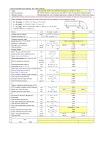Should you receive calls from the field indicating that the pump is not functioning properly.The Troubleshooting Guide in this video tutorial will allows you to review and diagnose potential problems that may be encountered with pumps. The guide outlines common pumping problems and failures with probable causes and procedures for checking and correcting possible faults.
Between regular maintenance inspections, be alert for signs of motor or pump trouble. Correct any trouble immediately to AVOID COSTLY REPAIR AND SHUTDOWN.
The following list may aid you in determining the problem.
■ Engine may not be running at the rated speed.
■ Strainer, inlet valve or the suction line may be clogged.
■ Suction line or fittings may leak air.
■ Mechanical seal may be worn and leaking air or water. Check weep hole.
■ There may be too much clearance between impeller and the volute due to wear. For best performance refer to manufacturer’s recommendations for proper adjustment.
■ Lining in the suction hose may be collapsing. This rubber lining inside the fabric layers may have pulled together under the vacuum created by the pump.
■ Suction lift may be too high. At a 25-foot lift the pump delivers only about 50% of the water it delivers at a 10-foot lift.
■ The suction hose may be too long, causing excessive friction loss and reducing pump capacity.
■ Discharge head may be too high. Check hose or pipe friction losses. A larger hose or pipe may correct this condition.
If the pump does not develop enough pressure:
■ Engine may not be running at its rated speed.
■ Mechanical seal may be leaking. Check weep hole.
■ There may be too much clearance between the impeller and pump body or volute due to wear. For good performance, refer to the manufacturer’s instructions for proper adjustment.
If the pump does not prime properly:
■ Make sure that the pump casing is filled with water.
■ Look in the suction line or fittings. Check to see that all fittings are tight in the suction line and make sure there is no leak in the hose itself.
■ Mechanical seal may be worn and leaking air.
■ Inlet valve rubber may be frozen to the seat.
■ Pump may be running too slowly.
■ The clearance between the impeller and pump body or volute may be greatly worn. Refer to the manufacturer’s instruction manual for proper adjustment.
■ Suction lift may be too high. At sea level the pump should not be used on lifts in excess of 25 feet from the level of the water to the center of the impeller. Keep the pump as close to the water source as is safely possible.
■ Suction line or suction strainer may be clogged.
■ Water may be too warm for the suction lift being used (as the temperature of the water increases above 60°F, the practical suction lift will decrease) making priming difficult. It may be necessary to replace the water in the pump case with fresh cold water.
Making Your Pump Last :-
The following check list may aid you in keeping your pumps in top condition. Check the following points on a monthly basis:
■ Priming speed
■ Capacity
■ Noise in pump casing
■ Gaskets and O-rings
■ Shaft seal leakage of air or water
■ Hose, hose washers and suction strainer
Check the following performance points on the engine:
■ Crankcase oil level
■ Spark plug condition
■ Air cleaner
■ Unusual engine noise
■ Proper RPM
■ Carburetor adjustment
Note:-
Every six months, check the impeller for wear, and for clearance between the impeller face and the volute. Refer to the manufacturer’s recommendations. Check the shaft seal for wear, as well as the shaft sleeve. Clean the casing and volute passages.













0 Comments